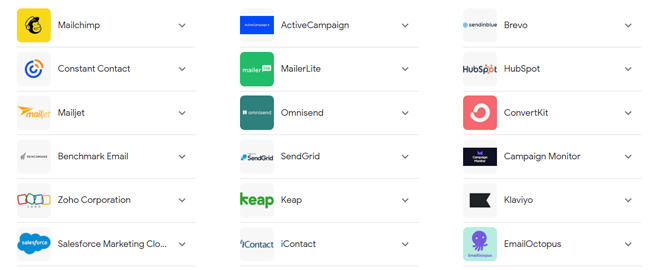Imagine quickly scanning your email marketing metrics and being able to pinpoint the areas that need improvement in less than five minutes.
Then picture yourself using this information to generate a confident report for your boss, asking them for budget approval and the go-ahead to implement the impressive content optimization ideas you have based on these insights.
Because your boss sees that this information is backed by real data, they immediately give you the green light, and you seize the opportunity to launch the best email marketing campaign of your career.
All of this can become a reality if you familiarize yourself with one of the most important email engagement metrics in the industry: the open rate formula.
Today, we’ll analyze this metric by breaking down the open rate formula and showing you how to effectively use it to achieve email marketing success. We’ll also cover:
- The benefits of having a high email open rate
- How you can analyze your competitor’s open rates and learn from their past mistakes
- How to optimize your content and maximize your return on investment in the process
Without further ado, let’s get straight into the ultimate guide to understanding and leveraging the open rate formula.
1 – What Is the Open Rate Formula?
The email open rate is a metric that measures the percentage of recipients who open an email out of the total number of emails delivered. It provides insights into recipient engagement and the effectiveness of your email campaigns.
There are several email marketing software and services available that can provide you with the information you need. This information often includes the total number of emails sent, delivered, and opened.
These tools are able to track with the use of tracking pixels or unique identifiers embedded in the email. When a recipient opens an email or clicks on a link, the software records this activity and updates the corresponding statistics in the reporting dashboard.
Some of these email marketing software and services include:

Consider a scenario in which you’re a digital marketer for a fictional brand called Level Company. They’ve recently launched an email campaign to promote a new product to its customer base.
You send out 1,000 emails, and 900 of them are successfully delivered. After the campaign, you track the open rate to assess the effectiveness of your email marketing efforts and find out that 200 of your emails were opened.
Here’s how you can apply the open rate formula to calculate the percentage of emails that were opened:
Open rate formula = (Number of emails opened / Number of emails delivered) * 100
Open rate = (200 / 900) * 100 = 22.2%
In this example, Level Company’s email open rate is 22.2%.
By calculating the email open rate, you can gauge how successful an email campaign was at capturing recipient attention. A higher open rate suggests that the content of your email, subject line, and sender name resonated with your audience.
A low open rate, on the other hand, may indicate that these same areas require improvement.
We recommend conducting an A/B testing experiment with different subject lines, personalization, or compelling content to find out what works and increase the open rate of future campaigns.
Fun Fact: Did you know that the word “Newsletter” in your email subject line can decrease your open rate by as much as 18.7%? Choose your words wisely!
2 – Benefits of Open Rate Formula
To maximize the benefits of your marketing efforts, it’s crucial to utilize all the available tools in your arsenal.
One important tool in this regard is calculating your open rate, which can provide valuable insights into key aspects of your email campaign. Understanding your open rate has many benefits, including:
Enhance Your Email Marketing Performance
By identifying segments with higher open rates, brands can tailor their messaging and offers to those specific segments, enhancing personalization and relevancy and improving overall campaign effectiveness.
For example, imagine you work for a clothing brand called Trendsetter Apparel that regularly sends out email newsletters to its subscriber base.
You’ve been tracking the brand’s email open rates and you notice that subject lines with personalized recommendations for a specific user persona have a significantly higher open rate compared to generic email subject lines.
Using this data, you personalize all subject lines to include tailored product recommendations, visually appealing images, and exclusive discounts for each segment in your email list.
As a result, Trendsetter Apparel witnesses a significant increase in its open rates and engagement.
By continuously monitoring open rates, you can measure the impact of these changes and make data-driven decisions to further optimize your email marketing strategy.
This could involve experimenting with different content formats, testing different send times, or refining your audience targeting, all aimed at improving your overall email marketing performance.
“Email has an ability many channels don’t: creating valuable, personal touches—at scale.”
— David Newman, Marketing Expert
Benchmark Against Your Competitors
Watching your competitors is crucial for business success.
By keeping an eye on their activities, you can gain insights into new market developments, emerging customer preferences, and evolving industry dynamics.
This knowledge helps you adapt and adjust your own business strategies to remain competitive and relevant in the market.
However, it’s not possible to directly access your competitors’ email open rates unless they make them publicly available or willingly share them with you, which is highly unlikely.
Nonetheless, you can still gain insight into your competitor’s email marketing performance by analyzing their overall email strategy, content, frequency, and observing any publicly available data or customer feedback.
Competitor analysis allows you to learn from the successes and failures of your rivals. By observing what strategies or campaigns have worked well for them, you can gain inspiration and insight that can be applied to your own business.
Similarly, studying your competitors’ failures and missteps can help you avoid making similar mistakes and make informed decisions that minimize risks. This learning process saves you time and resources by leveraging the experiences of others in the industry.
Drive Overall Marketing ROI
When you implement the above principles and experience increased email open rates, you increase the likelihood of recipients reading the full email content, clicking on links, and taking desired actions.
In turn, this can drive higher conversion rates, improve overall marketing return on investment (ROI), and contribute to your brand’s bottom line.
For instance, let’s say you conducted an A/B test and found the golden email that contains content that drives the highest email open rate.
When you send it out to your subscribers, they engage with the email and may even take a desired action, such as making a purchase, subscribing to a service, or completing a form, increasing the likelihood of them converting into loyal customers.
By optimizing email open rates, your brand increases the chances of recipients progressing through your sales or conversion funnel, ultimately boosting the conversion rates of your email campaigns.
Key Takeaway: Understanding your open rate formula allows for personalized messaging, effective benchmarking, and increased overall marketing ROI.
3 – How to Improve Your Email Open Rate
“You can’t miss what you never had.”
— Hunter S. Thompson
When a customer signs up for your email list, it could be because they recognize you as an industry leader or because they want to be first in line to receive special deals or limited-time offers.
However, if they encounter emails with drab subject lines, generic content, and unappealing offers, they’ll assume that they’re not missing out on much and may stop opening your emails altogether.
Prevention is better than cure. So, let’s look at how you can improve your open rate so you don’t have to deal with any of this.
Craft Compelling Email Subject Lines That Capture Attention
First impressions matter.
Since the subject line is the first thing recipients see in their inbox, it plays a crucial role in determining whether they’ll open an email or not. To optimize email subject lines and improve open rates, focus on:
- Personalization: People really love hearing their name, it’s their favorite sound. Tailor your subject lines to include the recipient’s name and other relevant personalized information.
For example, a subject line like “Heads up, John! Exclusive Offer Inside: 50% Off on Your Favorite Products” is more likely to grab John’s attention and entice him to open the email. - Creating a sense of urgency or exclusivity: Use subject lines that create a sense of urgency or offer exclusive benefits to tap into people’s fear of missing out on a great deal or opportunity.
For example, “Limited Time Offer: Last Chance to Save 50%!” or “Exclusive Invitation: Be the First to Access our New Product Line.” - Avoiding spam triggers: Ensure subject lines don’t trigger spam filters. By avoiding these triggers, you maintain a professional and credible image, which builds trust with your audience.
Avoid excessive use of capital letters, punctuation, or words that commonly trigger spam filters, such as “Free,” “Earn money fast,” and “Urgent.”
Warning: Don’t overwhelm your subscribers with too many emails. This can lead to an increase in unsubscriptions and spam complaints.
Utilize Segmentation to Send Relevant Content to the Right People
Segmentation is the ultimate secret for getting high email open rates.
By segmenting your email list and sending targeted, personalized content to specific groups of recipients, you can ensure that your emails are relevant to their interests, preferences, and needs.
When recipients receive emails that are tailored to their specific characteristics, they’re more likely to find the content valuable and engaging, leading to higher open rates. You can segment your email list in a few ways, including:
- Demographic segmentation: Divide the email list based on demographic factors such as age, location, or gender. These factors play a significant role in shaping the lives of your customers.
For example, a travel company can send customized emails offering family-friendly destinations and packages to subscribers with children. - Behavioral segmentation: Segment your list based on past customer actions to set up automated email campaigns triggered by specific behaviors.
If a subscriber abandons their shopping cart, send a follow-up email reminding them to complete their purchase.
By capitalizing on timely and relevant triggers, you create opportunities to re-engage with your audience and drive higher open rates. - Engagement-based segmentation: By segmenting your email list based on engagement levels, you can reward and recognize highly engaged subscribers who consistently open and click on your emails.
This recognition can take the form of exclusive content, advanced previews, early access to promotions, or special discounts.
When highly engaged subscribers receive emails that offer them additional value or exclusive benefits, they’re more likely to open and engage with those emails.
While proper segmentation greatly enhances open rates, it’s also crucial to avoid common email marketing pitfalls. The following table outlines these challenges, their consequences, and suggested preventive strategies.
| Pitfall | Consequences | Solution/Prevention Strategy |
| Ignoring mobile optimization | A large percentage of users check their emails on mobile devices. If emails aren’t optimized for mobile, open rates can significantly decrease | Ensure that all emails are mobile-friendly with responsive design. Test emails on various devices and screen sizes before sending |
| Irrelevant or uninteresting subject lines | If the subject line isn’t compelling or relevant, recipients might not be inclined to open the email | Use personalization, urgency, or curiosity in your subject lines. Conduct A/B testing to understand what types of subject lines resonate with your audience |
| Sending emails at the wrong time | Emails sent when recipients are less likely to check their inboxes may get buried under new emails, decreasing their visibility and open rate | Use analytics to understand the best time to send emails for your audience. This could vary by demographic, location, or behavior patterns |
| Overwhelming recipients with emails | If you send too many emails, recipients might find it irritating and ignore them, or worse, mark them as spam | Maintain a balanced email frequency. Monitor engagement rates and feedback to understand if the frequency needs adjustment |
| Failing to segment audience | Sending the same email to all subscribers, regardless of their interests or behaviors, can lead to lower open rates | Segment your audience based on demographics, behaviors, and engagement levels. Customize emails based on these segments for a more personalized approach |
Go Forth and Find Email Open Rate Success

You now understand the open rate formula and how it can help you measure email metrics.
“What gets measured gets managed.”
— Peter Drucker, Management Consultant and Author
With this knowledge, you can learn how to calculate your open rate, identify factors that influence it, and use that information to improve engagement and potentially encourage your customers to take desired actions.
By applying these strategies, you’ll be able to maximize your email marketing efforts and reach your target audience.
So don’t forget to track your open rate and use the insights you gain to refine your campaigns and create content that resonates with your subscribers.
At OnDigitalMarketing, we teach digital marketers and entrepreneurs how to achieve success in their online marketing endeavors by providing actionable advice and tips based on design thinking fundamentals.
Our methods have been adopted across 212 countries, 54 companies, and four universities. These methods have undergone an intense and in-depth peer review from third-party industry experts, ensuring that everything we teach is of the highest quality.
